
The Electric Company is an American educational children's television series produced by the Children's Television Workshop. It was co-created by Paul Dooley, Joan Ganz Cooney, and Lloyd Morrisett. The series aired on PBS for 780 episodes over the course of its six seasons from October 25, 1971, to April 15, 1977. The program continued in reruns until October 4, 1985. The Electric Company later reran on Noggin, a channel co-founded by the CTW, from 1999 to 2003. Noggin also produced a compilation special for the show.

High Noon is a 1952 American Western film produced by Stanley Kramer from a screenplay by Carl Foreman, directed by Fred Zinnemann, and starring Gary Cooper. The plot, which occurs in real time, centers on a town marshal whose sense of duty is tested when he must decide to either face a gang of killers alone, or leave town with his new wife.
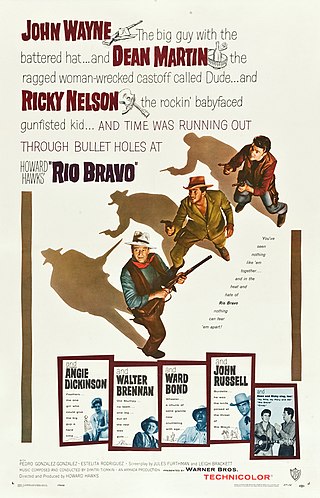
Rio Bravo is a 1959 American Western film directed and produced by Howard Hawks and starring John Wayne, Dean Martin, Ricky Nelson, Angie Dickinson, Walter Brennan, and Ward Bond. Written by Jules Furthman and Leigh Brackett, based on the short story "Rio Bravo" by B. H. McCampbell, the film stars Wayne as a Texan sheriff who arrests the brother of a powerful local rancher for murder and then has to hold the man in jail until a U.S. Marshal can arrive. With the help of a lame old man, a drunk, and a young gunfighter, they hold off the rancher's gang. Rio Bravo was filmed on location at Old Tucson Studios outside Tucson, Arizona, in Eastmancolor, with film processing provided by Technicolor.

Richard Donald Crenna was an American actor and television director.
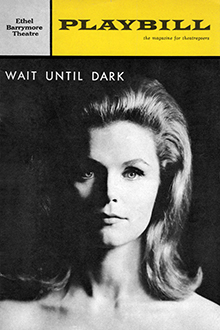
Wait Until Dark is a play by Frederick Knott, first performed on Broadway in 1966 and often revived since then. A film version was released in 1967, and the play was published in the same year.
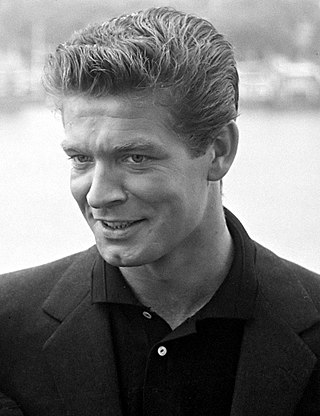
William Millar, better known by his stage name Stephen Boyd, was an actor from Northern Ireland. He emerged as a leading man during the late 1950's with his role as the villainous Messala in Ben-Hur (1959), a role that earned him the Golden Globe Award for Best Supporting Actor – Motion Picture. He received his second Golden Globe nomination for the musical Billy Rose's Jumbo (1962).
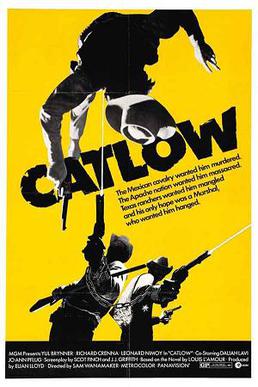
Catlow is a 1971 American Western film, based on a 1963 novel of the same name by Louis L'Amour. It stars Yul Brynner as a renegade outlaw determined to pull off a Confederate gold heist. It co-stars Richard Crenna and Leonard Nimoy. Nimoy mentioned this film in both of his autobiographies because it gave him a chance to break away from his role as Spock on Star Trek. He mentioned that the time he made the film was one of the happiest of his life, even though his part was rather brief. The film contains a lot of tongue-in-cheek and sardonic humor, especially between Brynner and Crenna's characters.

Peter Collinson was a British film director probably best remembered for directing The Italian Job (1969).
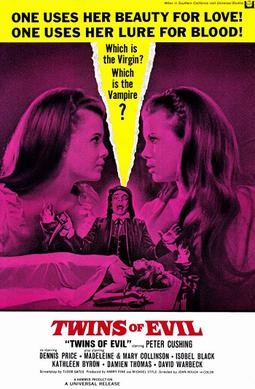
Twins of Evil is a 1971 British horror film directed by John Hough and starring Peter Cushing, with Damien Thomas and the real-life identical twins and former Playboy Playmates Mary and Madeleine Collinson.
Out of the Ashes is a 2003 American made-for-television biographical drama film that was released by Showtime. It is a dramatization of the life of Holocaust concentration camp survivor Gisella Perl and is based on her book I Was a Doctor in Auschwitz. The film is dedicated to the memory of Richard Crenna, who died three months before it was released.

Wait Until Dark is a 1967 American psychological thriller film directed by Terence Young and produced by Mel Ferrer, from a screenplay by Robert Carrington and Jane-Howard Carrington, based on the 1966 play of the same name by Frederick Knott. The film stars Audrey Hepburn as a blind woman, Alan Arkin as a violent criminal searching for drugs, and Richard Crenna as another criminal, supported by Jack Weston, Julie Herrod, and Efrem Zimbalist Jr.

James Allen Preston is a retired American actor. Preston is best known for portraying Colonel Randolph in the movie A Few Good Men and for his role as Ozzie Cleveland on the NBC prime-time television series Hill Street Blues. He played Conn MacCleary in the movie Remo Williams: The Adventure Begins.
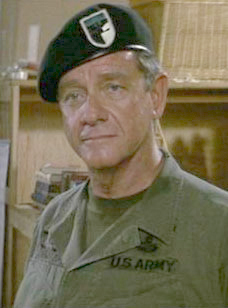
Colonel Samuel Richard "Sam" Trautman is a fictional character in the Rambo novel and film series, and other media in the franchise. His first appearance was in David Morrell's novel First Blood. His character was expanded on in the film series where he was played by Richard Crenna.
The Lost Man Booker Prize was a special edition of the Man Booker Prize awarded by a public vote in 2010 to a novel from 1970 as the books published in 1970 were not eligible for the Man Booker Prize due to a rules alteration; until 1970 the prize was awarded to books published in the previous year, while from 1971 onwards it was awarded to books published the same year as the award. The prize was won by J. G. Farrell for Troubles.

Stone Cold Dead is a 1979 Canadian film directed by George Mendeluk and starring Richard Crenna and Paul Williams.

Those Dirty Dogs is a 1973 Italian-Spanish Spaghetti Western film written and directed by Giuseppe Rosati and starring Gianni Garko and Stephen Boyd. The film was made in the later part of the Spaghetti Western boom. As such it features such latter-day genre elements as self-parody, guffaw humour, near-slapstick fight scenes, machine guns hidden in everyday household items, and bombastic villains.
Imposters is an American dark comedy television series. The show premiered February 7, 2017, on the Bravo cable network with a 10-episode season. Announced in April 2015 as My So Called Wife, the series follows con artist Maddie, played by Inbar Lavi, who gets involved in relationships with men and women before leaving them "used and robbed of everything – including their hearts". On April 17, 2017, Bravo renewed the series for a second season, which premiered on April 5, 2018. On June 1, 2018, Bravo canceled the series after two seasons.

José Jaspe was a Spanish film actor.
Double Indemnity is a 1973 American made-for-television crime film directed by Jack Smight and starring Richard Crenna, Lee J. Cobb, Robert Webber and Samantha Eggar. It was a remake of Double Indemnity (1944) based on the film rather than the original novel.















